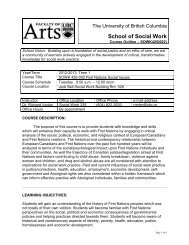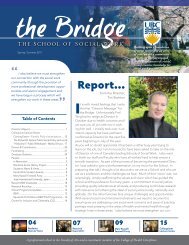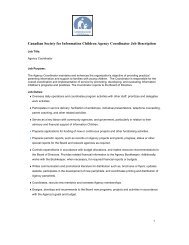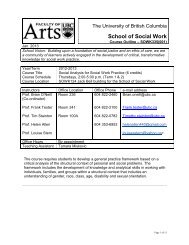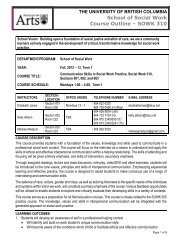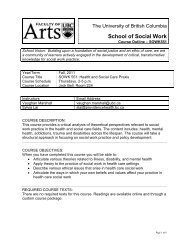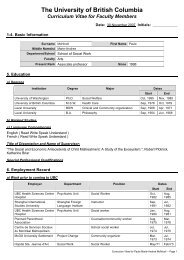Equity Case Studies Report - School of Social Work - University of ...
Equity Case Studies Report - School of Social Work - University of ...
Equity Case Studies Report - School of Social Work - University of ...
You also want an ePaper? Increase the reach of your titles
YUMPU automatically turns print PDFs into web optimized ePapers that Google loves.
UBC school <strong>of</strong> social work equity and diversity strategic plan: A compilation <strong>of</strong> case studies 63<br />
people in. The academy must be willing to look at those institutional barriers that make<br />
it difficult for people to stay. (pp. 478-479)<br />
Despite the values promoted in the <strong>Social</strong> <strong>Work</strong> pr<strong>of</strong>ession regarding social justice, equity,<br />
diversity, and inclusion, <strong>School</strong>s and Faculties <strong>of</strong> <strong>Social</strong> <strong>Work</strong> deeply struggle with the issues<br />
raised by MacDonald et al. (2003). This is obviously explained by a history <strong>of</strong> the pr<strong>of</strong>ession<br />
and the ways that <strong>School</strong>s and Faculties emerged in the North American context. Therefore, it is<br />
necessary to ask, what policies and mechanisms need to be put in place to diminish institutional<br />
barriers? Second, how can it be ensured that such policies and mechanisms are actually<br />
implemented? An example <strong>of</strong> a <strong>School</strong> <strong>of</strong> <strong>Social</strong> <strong>Work</strong> that has paid a great deal <strong>of</strong> attention to<br />
these challenges is at Dalhousie <strong>University</strong>. The <strong>School</strong> has an affirmative action policy for both<br />
students and faculty who identify as Acadian, Aboriginal, African Canadian, members <strong>of</strong> other<br />
racially visible groups, persons with (dis)Abilities, and Lesbian, Gay, Bisexual, Transgendered,<br />
Two Spirited, Queer, and Intersex (LGBTTQI). The <strong>School</strong> strives to hire the highest possible<br />
number <strong>of</strong> faculty who qualify under this policy, and to create and implement strategies to<br />
remove obstacles related to inequity and structural barriers that individuals may face in being<br />
recruited, hired, and in achieving tenure. The<br />
<strong>School</strong> stresses the need to engage in outreach<br />
recruitment initiatives, to establish designated<br />
Therefore, it is necessary to ask, what policies and<br />
mechanisms need to be put in place to diminish<br />
institutional barriers? Second, how can it be ensured that<br />
such policies and mechanisms are actually implemented?<br />
positions, and to actively recruit faculty members from designated equity groups. Furthermore,<br />
practices that “recognize historic exclusion and that moves beyond tokenism and the institutional<br />
comfort zone to develop sensitized collegial relationships” is essential for faculty retention<br />
(MacDonald et al., 2003, p. 478). An example <strong>of</strong> successfully implementing their affirmative<br />
action policy was the recruitment and hiring <strong>of</strong> a faculty member from a designated group in



